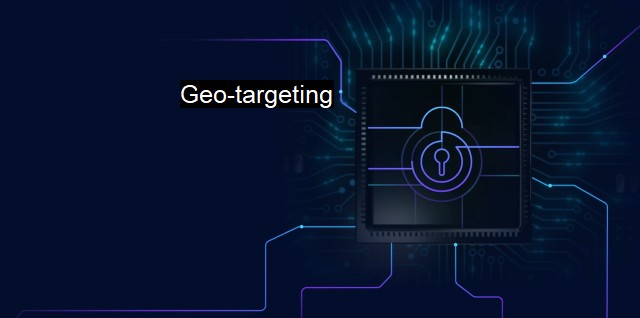What is Geo-targeting?
The Importance of Geo-Targeting in Cybersecurity: Protecting Digital Data and Businesses in a Globally Connected World
Geo-targeting, often synonymous with location-based targeting, is a technological practice which involves identifying the geographical location of a website visitor via their digital data and serving them tailored and region-specific content. Not to be confused with geofencing, which is another form of geographical targeting where an area is sectioned off for unique marketing, geo-targeting deals more with generalized adjustments made to reach diverse geographical regions.Geo-targeting has become a significant feature. Its application is twofold in this regard; firstly, helping enhance security measures, and secondly, frustratingly, becoming a tool for cyber miscreants to deliberately target their attacks.
With regards to enhancing security measures, geo-targeting is used by some antivirus software to identify the location of potential threats. Unusual or suspicious activities, such as login attempts from unexpected locations can signal potential breaches. This intelligence is vital for today’s organizations who either have location-sensitive data or multi-location access to their systems. Based on the location data, protective actions, like blocking the access or triggering multi-factor authentication, can be carried out. Another practical implication for antivirus software developers is prioritizing the update or patch release schedules based on the geo-targeted threat analysis. Thus, providing an extra shield against the most prevalent threats in various geographical areas.
Interestingly, geo-targeting has also become essential for Corporate VPNs to enable or disable access based on geography. This reinforces the organization’s cybersecurity posture by narrowing the threat surface.
Addressing legal compliance at different locations becomes a lot clearer with geo-targeting. Firms can confidently maintain their GDPR compliance by managing access requests made outside EU territories, for example. Therefore, geo-targeting has geofencing possible without physically barcoding the world.
Nonetheless, not all aspects of geo-targeting reinforce cybersecurity. Arguably the darker side of geo-targeting is how it can pose severe threats to cybersecurity. Cybercriminals and hackers have harnessed this technology as part of their toolkit. They use geo-targeting to launch specific attacks against organizations or various regions based on their understanding of vulnerabilities, response times, technological proficiency, and current security controls. targeted cyber threats to gain maximum impact from the breach.
For instance, geo-targeting tactics may be used to 'localize' phishing attacks, making their deceptive attempts more effective. Hackers could send malware-infected emails that appear as if they originate from a legitimate local vendor purporting to offer region-specific services to trick users into handing over sensitive information or downloading malicious data. This notion feeds into a complex issue where cybercriminals constantly adapt to exploit advanced technologies for their nefarious aims.
While geo-targeting offers many advantages in providing personalized user experiences and enhancing cybersecurity efforts, unchecked use and misuse can lead to targeted threats. Therefore, as internet users become more geographically distinguishable, substantial effort must be invested to improve the security of personal data and raise public awareness about the potential dangers of geo-targeted cybersecurity attacks. Striking a balance between securing data from threats and exploiting location data for user convenience is the modern-day challenge in the landscape of cybersecurity.

Geo-targeting FAQs
What is GEO-targeting when it comes to cybersecurity?
GEO-targeting is a cybersecurity practice that utilizes location-based data to protect against online threats. It involves analyzing the geographic location of internet traffic and using that information to customize security measures and block or allow access to certain areas based on their risk level.How can GEO-targeting help prevent cyber-attacks?
By using GEO-targeting, cybersecurity experts can identify and block traffic from known risky locations such as countries with high levels of cybercrime, compromised IP addresses and open proxy servers. This helps prevent cybercriminals from accessing your system or network, reducing the risk of a potential cyber-attack.What are some of the benefits of using GEO-targeting in antivirus software?
GEO-targeting can help antivirus software to focus its scans and updates on areas that need them the most, resulting in faster and more efficient protection. Additionally, it can help reduce false positives by identifying legitimate traffic from certain geographic locations and allowing it through with minimal interference.Is it possible to bypass GEO-targeting in cybersecurity?
While there are ways cybercriminals can attempt to bypass GEO-targeting, such as using a VPN or proxy server to disguise their location, the practice remains an effective tool in cybersecurity. Regular monitoring and updates of GEO-targeting practices can help keep up with emerging threats and ensure continued protection.| | A | | | B | | | C | | | D | | | E | | | F | | | G | | | H | | | I | | | J | | | K | | | L | | | M | |
| | N | | | O | | | P | | | Q | | | R | | | S | | | T | | | U | | | V | | | W | | | X | | | Y | | | Z | |
| | 1 | | | 2 | | | 3 | | | 4 | | | 7 | | | 8 | | |||||||